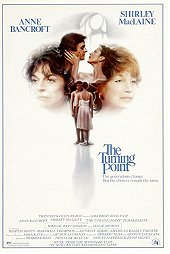Eleven Academy Award nominations.
Eleven Academy Award nominations.
This was all that kept running through my mind when I was watching The Turning Point, a thin film that somehow ended up with a lion’s share of nominations at that year’s Oscar telecast. That many nominations on a film this generically plotted, anemically directed and indifferently acted by most of the supporting cast found itself sailing in the Oscars in 1977 with the most nominations out of any other film that year. That it got shut out is no big surprise. Maybe the voters just got confused that a film about the world of ballet was intrinsically high-art worth celebrating because it was about a high-art worth celebrating?
No matter. All those nominations have done, fairly or unfairly, has saddled us with a preconceived notion that this is a film worth celebrating and remembering for some kind of high artistic achievement. Like it or not, an Oscar nomination (and moreso a win) is typically a barometer of some kind of high-level of success in the industry. The Turning Point is Lifetime movie material decades before the very idea of that type of movie-making even came into our pop culture vocabulary.
It tells the story of two former friends and ballet dancers, one who left the life to start a family (Shirley MacLaine) and the other who stayed and became a huge star (Anne Bancroft). MacLaine’s oldest daughter shows great promise as a dancer and Bancroft takes her under her tutelage and introduces her to the world of professional dance. This sets in motion the story beats for their decades-long cold war to explode in a climatic cat-fight. Meanwhile, MacLaine’s daughter (Leslie Browne, inexplicably Oscar nominated) meets a sexy, brooding, womanizing bad boy dancer (Mikhail Baryshnikov, also Oscar nominated but he showed more promise as an actor). That’s the entirety of the sub-plot – good girl meets bad boy, romantic entanglements ensue, happy ending for the couple.
Amidst all of the too-tasteful-for-its-own-good film-making, Turning Point at least it offers MacLaine and Bancroft the offer to act their asses off, and they sink into these roles for everything that they’re worth. Sometimes the film does indulge in the worst of diva-centric tendencies, but at least when these two are sparring they’re immensely watchable and entertaining.
The other incredibly commendable aspect of the film is the extended sequences of actual ballet dancers doing what they do best. Not since The Red Shoes has a film about a ballerina showcased such lovely and extended dance sequences. But unlike Red Shoes, this film doesn’t have the imagination or creativity to do anything other than point-and-shoot the sequences. So all of the beauty and awe in the dance numbers come from watching trained professionals at the high of their talents do what they love, the costumes and sets.
It’s such a pity that The Turning Point turned out so boring. There’s clearly a better movie to be made out of ballet. Black Swan and The Red Shoes come to mind as films set within the world that do something better to explore it and place us in the minds/bodies of the dancers. Turning Point is pure sappy melodrama from start-to-finish with terrible dialog, wooden acting from Browne and several other supporting actors, and a cliché ridden script that sign-posts its motivations and plot twists thirty minutes in advance with no subtly or complications. To put it more distinctly, it’s boring outside of the two lead performances and watching talented ballet dancers twist and contort.
 Login
Login